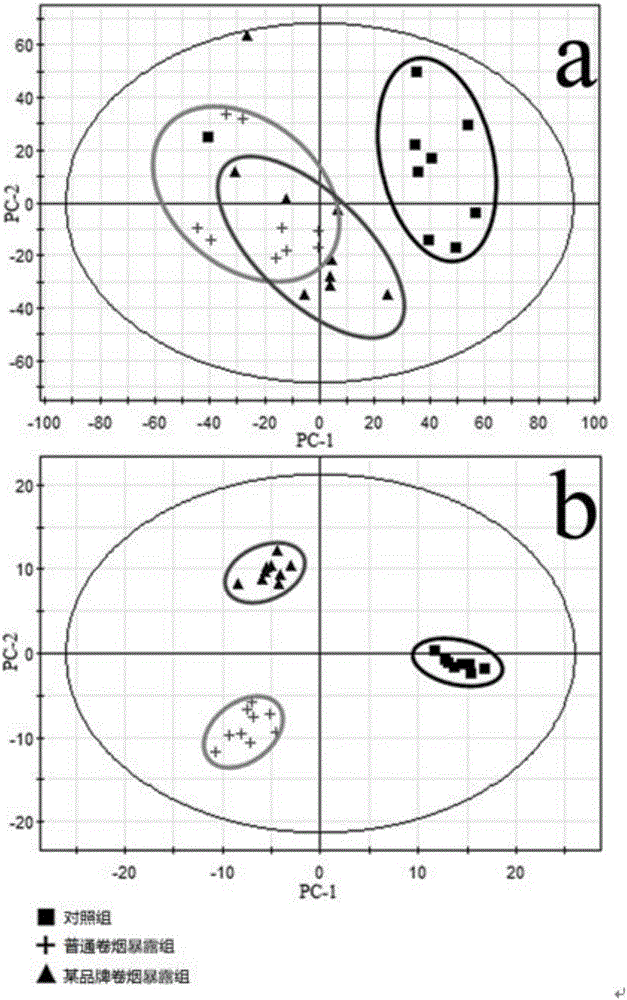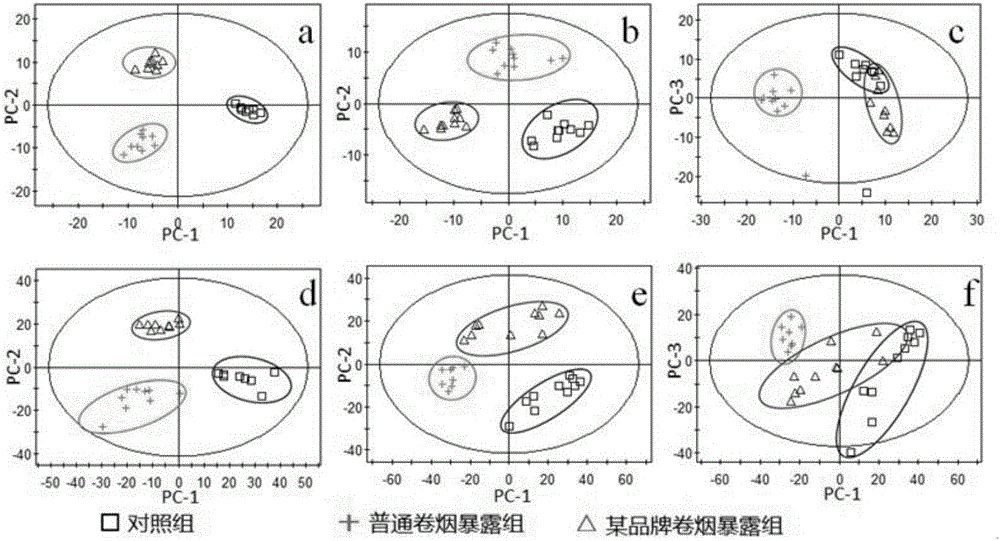Test method for characterizing smoke exposure biological effect based on metabonomics
A metabolomics and test method technology, which is applied in the field of tests based on metabolomics to characterize the biological effects of smoke exposure, and achieves the effect of simple operation.
- Summary
- Abstract
- Description
- Claims
- Application Information
AI Technical Summary
Problems solved by technology
Method used
Image
Examples
Embodiment 1
[0029] 1) After one week of adaptive feeding, the rats were immediately divided into: blank group, control group and experimental group; the cigarettes were fixed in the terrarium by a metal sleeve, and each rat smoked 1 cigarette per day. The rats were fasted for 12 hours before and after the operation, and they had free drinking water.
[0030] 2) Animal treatment and sample collection: After 7 days of exposure to smoke, the rats were weighed. After anesthesia, about 6-8 mL of blood was taken from the hepatic portal vein and placed in a 10 mL centrifuge tube treated with heparin sodium. Centrifuge at 3000 rpm for 10 min, take the upper layer of plasma, and store each biological sample at -80°C.
[0031] 3) Before LC-MS analysis, take 100μL of the frozen-thawed plasma sample, add 400μL of methanol, vortex for 1min, mix well to precipitate the protein, then centrifuge at 13000rpm at 4℃ for 15min, take the supernatant and add 300μL of ultrapure Dilute with water and filter with 0.2...
Embodiment 2
[0038] 1) After one week of adaptive feeding, the rats were immediately divided into: blank group, control group and experimental group; the cigarettes were fixed in the terrarium by a metal sleeve, and each rat smoked 1 cigarette a day. The rats were fasted for 12 hours before and after the operation, and they had free drinking water.
[0039] 2) Animal handling and sample collection: After exposure to smoke for 7, 14, and 30 days, the rats are weighed, and the rats’ urine for 24 hours is collected in a metabolic cage. After anesthesia, about 6-8 mL of blood is taken from the portal vein of the liver. , Put it into a 10mL centrifuge test tube treated with heparin sodium, quickly centrifuge at 3000rpm for 10min, take the upper layer of plasma, and store each biological sample at -80°C.
[0040] 3) Before LC-MS analysis, take 100μL of frozen-thawed plasma or urine sample, add 400μL methanol, vortex for 1min, mix well to precipitate the protein, then centrifuge at 13000rpm at 4℃ for ...
Embodiment 3
[0047] 1) After one week of adaptive feeding, the rats are then divided into: blank group, control group and experimental group; the cigarettes are fixed in the terrarium by a metal sleeve, and each rat is exposed for 20 minutes a day to control the smoke shading rate of cigarettes The control temperature is 22±2°C, the humidity is maintained at 21±0.5%, the oxygen concentration is maintained at 21±0.5%, and the pressure is 101325±40Pa. The rats were fasted for 12 hours before and after the operation, and they had free drinking water.
[0048] 2) Animal handling and sample collection: Weigh the rats at 7 days, 14 days and 30 days after smoke exposure. After anesthesia, take the rat lung tissue, wash it with normal saline and absorb the water with filter paper, then weigh it , Store at -80℃.
[0049] 3) Pretreatment of lung tissue samples: Take the lung tissue samples after freezing and thawing, and homogenize them by adding physiological saline at 1:3 (g / mL). Take 200μL of homoge...
PUM
 Login to View More
Login to View More Abstract
Description
Claims
Application Information
 Login to View More
Login to View More - Generate Ideas
- Intellectual Property
- Life Sciences
- Materials
- Tech Scout
- Unparalleled Data Quality
- Higher Quality Content
- 60% Fewer Hallucinations
Browse by: Latest US Patents, China's latest patents, Technical Efficacy Thesaurus, Application Domain, Technology Topic, Popular Technical Reports.
© 2025 PatSnap. All rights reserved.Legal|Privacy policy|Modern Slavery Act Transparency Statement|Sitemap|About US| Contact US: help@patsnap.com



